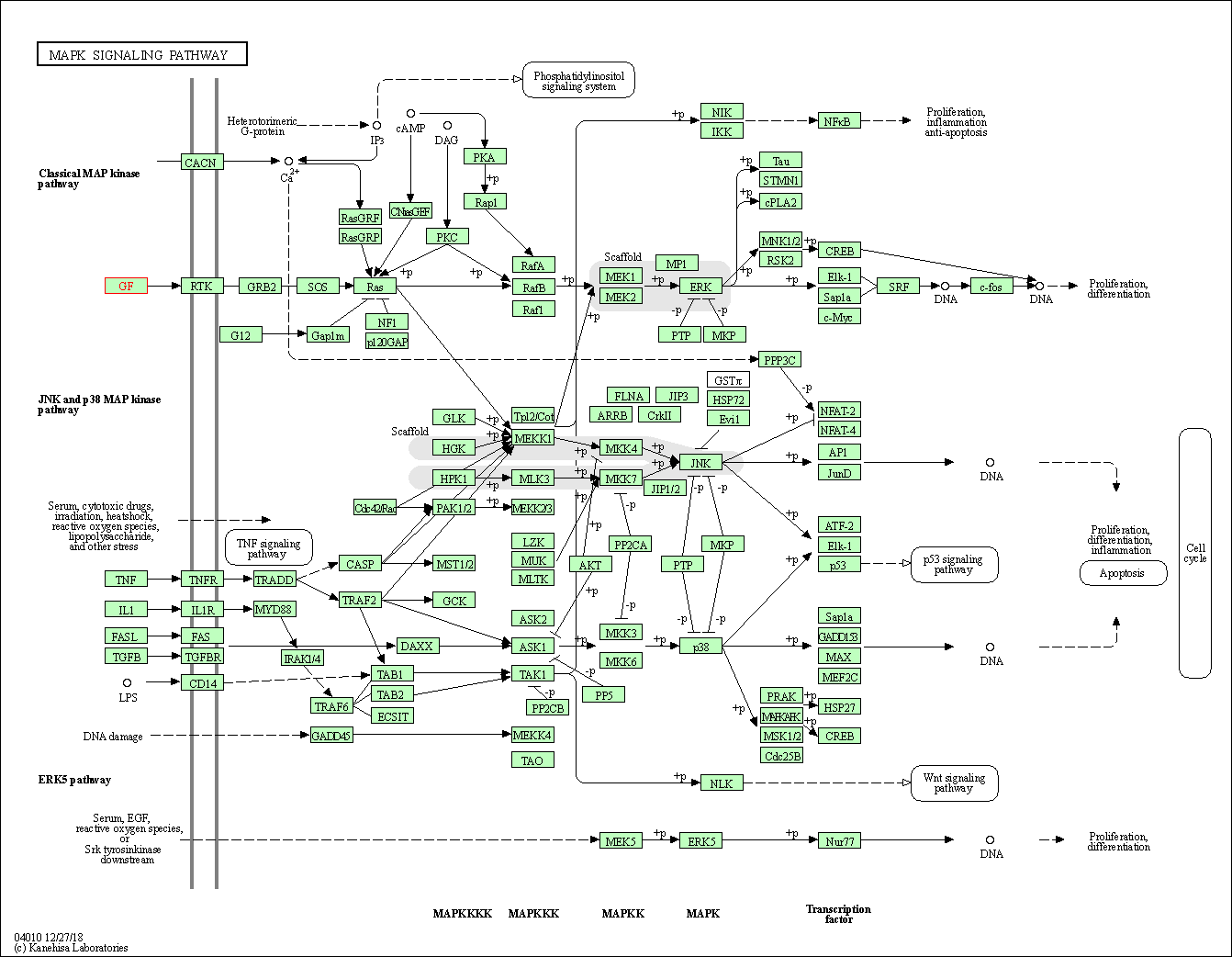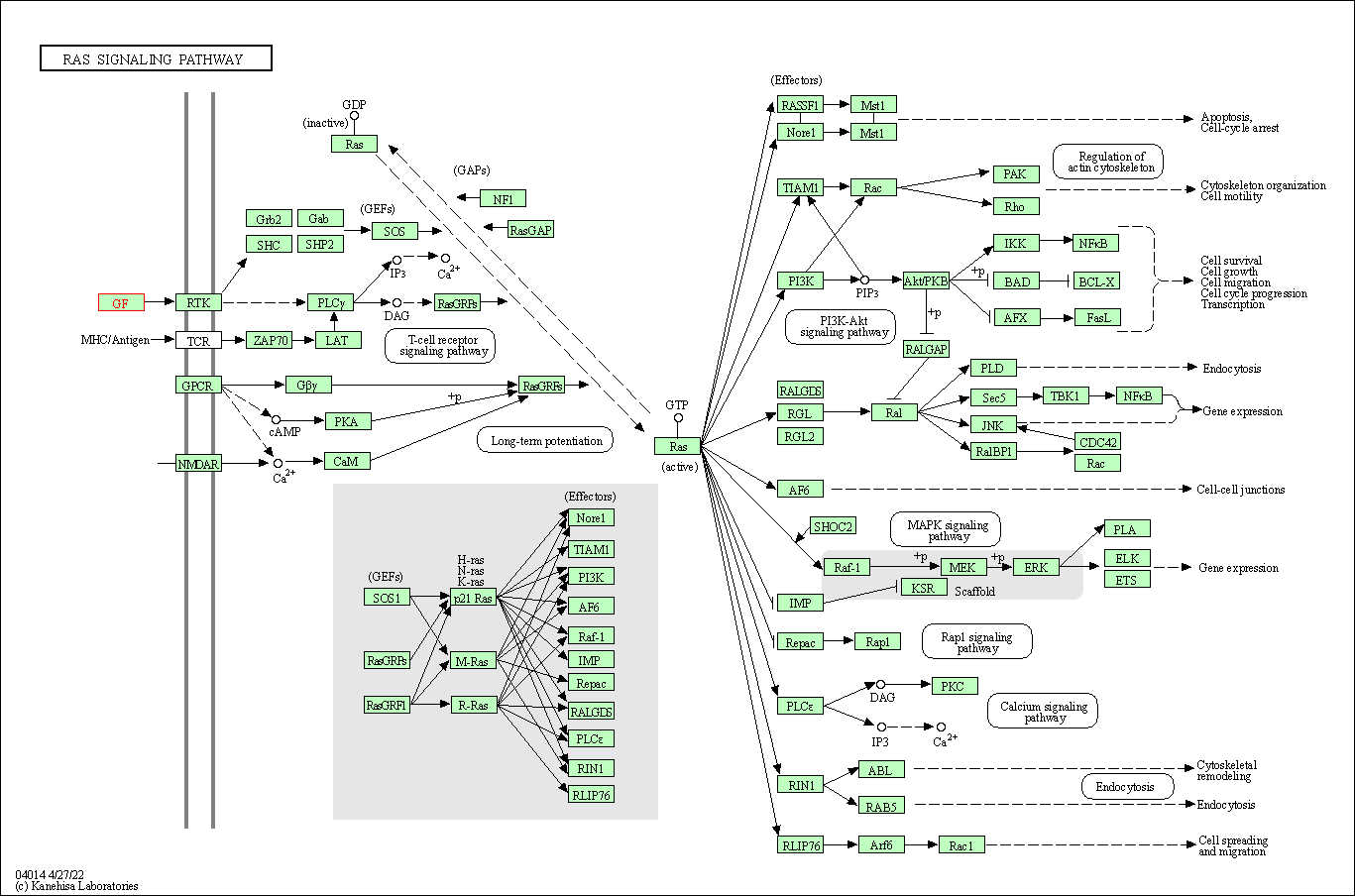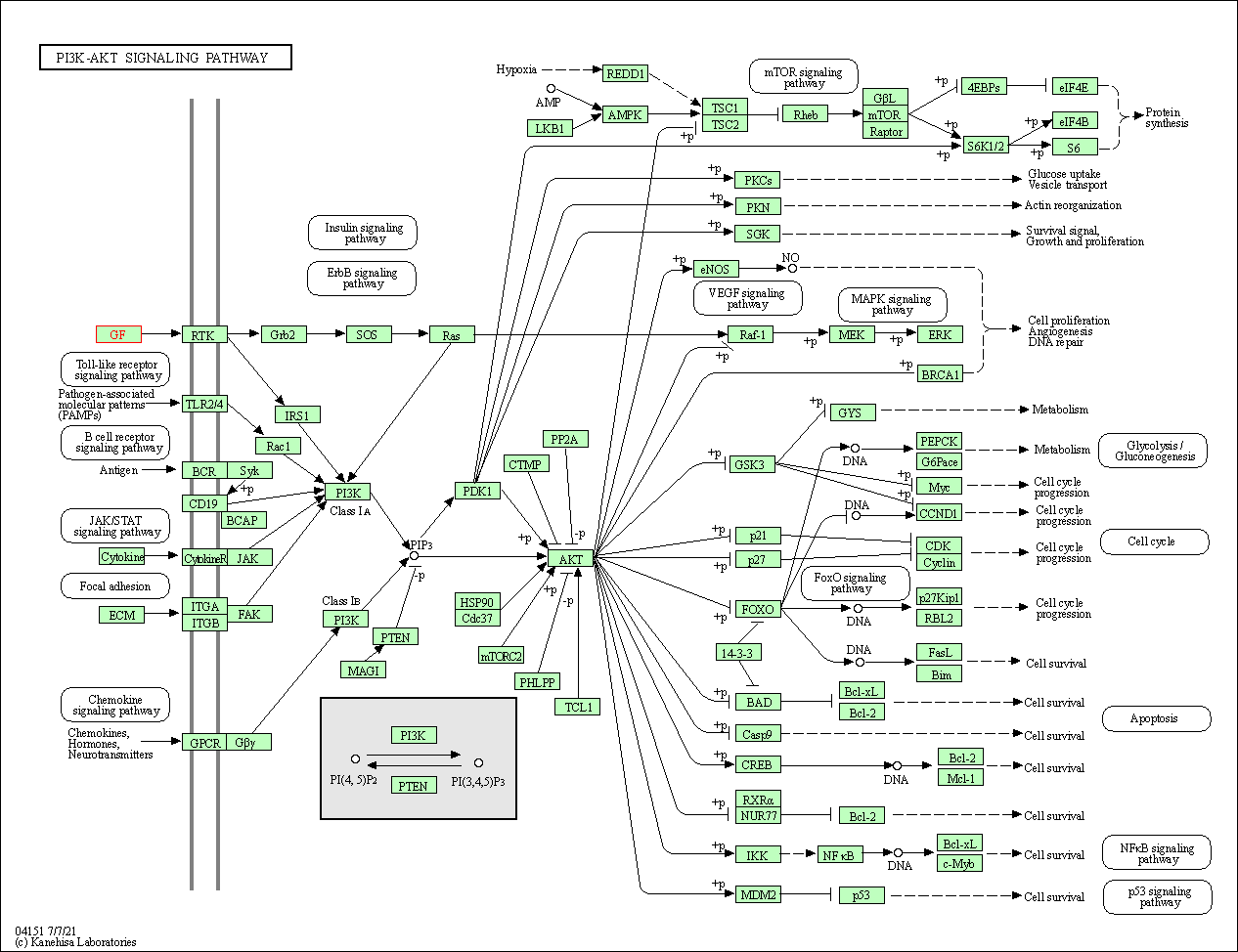Target Information
| Target General Information | Top | |||||
|---|---|---|---|---|---|---|
| Target ID |
T21960
(Former ID: TTDC00210)
|
|||||
| Target Name |
Angiopoietin-2 (ANGPT2)
|
|||||
| Synonyms |
ANG-2
Click to Show/Hide
|
|||||
| Gene Name |
ANGPT2
|
|||||
| Target Type |
Successful target
|
[1] | ||||
| Disease | [+] 1 Target-related Diseases | + | ||||
| 1 | Retinopathy [ICD-11: 9B71] | |||||
| Function |
Can induce tyrosine phosphorylation of TEK/TIE2 in the absence of ANGPT1. In the absence of angiogenic inducers, such as VEGF, ANGPT2-mediated loosening of cell-matrix contacts may induce endothelial cell apoptosis with consequent vascular regression. In concert with VEGF, it may facilitate endothelial cell migration and proliferation, thus serving as a permissive angiogenic signal. Binds to TEK/TIE2, competing for the ANGPT1 binding site, and modulating ANGPT1 signaling.
Click to Show/Hide
|
|||||
| BioChemical Class |
Fibrinogen protein
|
|||||
| UniProt ID | ||||||
| Sequence |
MWQIVFFTLSCDLVLAAAYNNFRKSMDSIGKKQYQVQHGSCSYTFLLPEMDNCRSSSSPY
VSNAVQRDAPLEYDDSVQRLQVLENIMENNTQWLMKLENYIQDNMKKEMVEIQQNAVQNQ TAVMIEIGTNLLNQTAEQTRKLTDVEAQVLNQTTRLELQLLEHSLSTNKLEKQILDQTSE INKLQDKNSFLEKKVLAMEDKHIIQLQSIKEEKDQLQVLVSKQNSIIEELEKKIVTATVN NSVLQKQQHDLMETVNNLLTMMSTSNSAKDPTVAKEEQISFRDCAEVFKSGHTTNGIYTL TFPNSTEEIKAYCDMEAGGGGWTIIQRREDGSVDFQRTWKEYKVGFGNPSGEYWLGNEFV SQLTNQQRYVLKIHLKDWEGNEAYSLYEHFYLSSEELNYRIHLKGLTGTAGKISSISQPG NDFSTKDGDNDKCICKCSQMLTGGWWFDACGPSNLNGMYYPQRQNTNKFNGIKWYYWKGS GYSLKATTMMIRPADF Click to Show/Hide
|
|||||
| 3D Structure | Click to Show 3D Structure of This Target | AlphaFold | ||||
| HIT2.0 ID | T29PJS | |||||
| Drugs and Modes of Action | Top | |||||
|---|---|---|---|---|---|---|
| Clinical Trial Drug(s) | [+] 7 Clinical Trial Drugs | + | ||||
| 1 | AMG 386 | Drug Info | Phase 3 | Neuropathic pain | [4] | |
| 2 | RG7221 | Drug Info | Phase 2 | Colorectal cancer | [6] | |
| 3 | RO5520985 | Drug Info | Phase 2 | Colorectal cancer | [7] | |
| 4 | CVX-060 | Drug Info | Phase 1/2 | Solid tumour/cancer | [8] | |
| 5 | CVX-241 | Drug Info | Phase 1 | Solid tumour/cancer | [13] | |
| 6 | LY3127804 | Drug Info | Phase 1 | Solid tumour/cancer | [14] | |
| 7 | REGN-910 | Drug Info | Phase 1 | Solid tumour/cancer | [15], [16], [17] | |
| Mode of Action | [+] 1 Modes of Action | + | ||||
| Modulator | [+] 4 Modulator drugs | + | ||||
| 1 | AMG 386 | Drug Info | [1] | |||
| 2 | RG7221 | Drug Info | [18] | |||
| 3 | RO5520985 | Drug Info | [19] | |||
| 4 | CVX-241 | Drug Info | [13], [20] | |||
| Cell-based Target Expression Variations | Top | |||||
|---|---|---|---|---|---|---|
| Cell-based Target Expression Variations | ||||||
| Different Human System Profiles of Target | Top |
|---|---|
|
Human Similarity Proteins
of target is determined by comparing the sequence similarity of all human proteins with the target based on BLAST. The similarity proteins for a target are defined as the proteins with E-value < 0.005 and outside the protein families of the target.
A target that has fewer human similarity proteins outside its family is commonly regarded to possess a greater capacity to avoid undesired interactions and thus increase the possibility of finding successful drugs
(Brief Bioinform, 21: 649-662, 2020).
Human Tissue Distribution
of target is determined from a proteomics study that quantified more than 12,000 genes across 32 normal human tissues. Tissue Specificity (TS) score was used to define the enrichment of target across tissues.
The distribution of targets among different tissues or organs need to be taken into consideration when assessing the target druggability, as it is generally accepted that the wider the target distribution, the greater the concern over potential adverse effects
(Nat Rev Drug Discov, 20: 64-81, 2021).
Human Pathway Affiliation
of target is determined by the life-essential pathways provided on KEGG database. The target-affiliated pathways were defined based on the following two criteria (a) the pathways of the studied target should be life-essential for both healthy individuals and patients, and (b) the studied target should occupy an upstream position in the pathways and therefore had the ability to regulate biological function.
Targets involved in a fewer pathways have greater likelihood to be successfully developed, while those associated with more human pathways increase the chance of undesirable interferences with other human processes
(Pharmacol Rev, 58: 259-279, 2006).
Biological Network Descriptors
of target is determined based on a human protein-protein interactions (PPI) network consisting of 9,309 proteins and 52,713 PPIs, which were with a high confidence score of ≥ 0.95 collected from STRING database.
The network properties of targets based on protein-protein interactions (PPIs) have been widely adopted for the assessment of target’s druggability. Proteins with high node degree tend to have a high impact on network function through multiple interactions, while proteins with high betweenness centrality are regarded to be central for communication in interaction networks and regulate the flow of signaling information
(Front Pharmacol, 9, 1245, 2018;
Curr Opin Struct Biol. 44:134-142, 2017).
Human Similarity Proteins
Human Tissue Distribution
Human Pathway Affiliation
Biological Network Descriptors
|
|
|
There is no similarity protein (E value < 0.005) for this target
|
|
Note:
If a protein has TS (tissue specficity) scores at least in one tissue >= 2.5, this protein is called tissue-enriched (including tissue-enriched-but-not-specific and tissue-specific). In the plots, the vertical lines are at thresholds 2.5 and 4.
|
| KEGG Pathway | Pathway ID | Affiliated Target | Pathway Map |
|---|---|---|---|
| MAPK signaling pathway | hsa04010 | Affiliated Target |

|
| Class: Environmental Information Processing => Signal transduction | Pathway Hierarchy | ||
| Ras signaling pathway | hsa04014 | Affiliated Target |

|
| Class: Environmental Information Processing => Signal transduction | Pathway Hierarchy | ||
| Rap1 signaling pathway | hsa04015 | Affiliated Target |

|
| Class: Environmental Information Processing => Signal transduction | Pathway Hierarchy | ||
| HIF-1 signaling pathway | hsa04066 | Affiliated Target |

|
| Class: Environmental Information Processing => Signal transduction | Pathway Hierarchy | ||
| PI3K-Akt signaling pathway | hsa04151 | Affiliated Target |

|
| Class: Environmental Information Processing => Signal transduction | Pathway Hierarchy | ||
| Degree | 4 | Degree centrality | 4.30E-04 | Betweenness centrality | 2.03E-04 |
|---|---|---|---|---|---|
| Closeness centrality | 2.12E-01 | Radiality | 1.37E+01 | Clustering coefficient | 3.33E-01 |
| Neighborhood connectivity | 2.63E+01 | Topological coefficient | 3.02E-01 | Eccentricity | 12 |
| Download | Click to Download the Full PPI Network of This Target | ||||
| Target Regulators | Top | |||||
|---|---|---|---|---|---|---|
| Target-regulating microRNAs | ||||||
| Target-interacting Proteins | ||||||
| Target Profiles in Patients | Top | |||||
|---|---|---|---|---|---|---|
| Target Expression Profile (TEP) | ||||||
| Target Affiliated Biological Pathways | Top | |||||
|---|---|---|---|---|---|---|
| KEGG Pathway | [+] 4 KEGG Pathways | + | ||||
| 1 | Ras signaling pathway | |||||
| 2 | Rap1 signaling pathway | |||||
| 3 | HIF-1 signaling pathway | |||||
| 4 | PI3K-Akt signaling pathway | |||||
| NetPath Pathway | [+] 1 NetPath Pathways | + | ||||
| 1 | TGF_beta_Receptor Signaling Pathway | |||||
| Panther Pathway | [+] 1 Panther Pathways | + | ||||
| 1 | Angiogenesis | |||||
| PID Pathway | [+] 1 PID Pathways | + | ||||
| 1 | Angiopoietin receptor Tie2-mediated signaling | |||||
| Reactome | [+] 1 Reactome Pathways | + | ||||
| 1 | Tie2 Signaling | |||||
| WikiPathways | [+] 1 WikiPathways | + | ||||
| 1 | Cell surface interactions at the vascular wall | |||||
| Target-Related Models and Studies | Top | |||||
|---|---|---|---|---|---|---|
| Target Validation | ||||||
| References | Top | |||||
|---|---|---|---|---|---|---|
| REF 1 | Interpreting expression profiles of cancers by genome-wide survey of breadth of expression in normal tissues. Genomics 2005 Aug;86(2):127-41. | |||||
| REF 2 | FDA Approved Drug Products from FDA Official Website. 2023. Application Number: 761235. | |||||
| REF 3 | ClinicalTrials.gov (NCT01281254) AMG 386 (Trebananib) in Ovarian Cancer (TRINOVA-2). U.S. National Institutes of Health. | |||||
| REF 4 | Emerging drugs in neuropathic pain. Expert Opin Emerg Drugs. 2007 Mar;12(1):113-26. | |||||
| REF 5 | ClinicalTrials.gov (NCT02713204) Anti-angiOpoeitin 2 Plus Anti-vascular eNdothelial Growth Factor as a therapY for Neovascular Age Related Macular Degeneration: Evaluation of a fiXed Combination Intravitreal Injection (ONYX). U.S. National Institutes of Health. | |||||
| REF 6 | Trusted, scientifically sound profiles of drug programs, clinical trials, safety reports, and company deals, written by scientists. Springer. 2015. Adis Insight (drug id 800037469) | |||||
| REF 7 | ClinicalTrials.gov (NCT02141295) A Study Comparing the Efficacy and Safety of Vanucizumab and FOLFOX With Bevacizumab and FOLFOX in Participants With Untreated Metastatic Colorectal Cancer | |||||
| REF 8 | Clinical pipeline report, company report or official report of CovX (2011). | |||||
| REF 9 | ClinicalTrials.gov (NCT01271972) Study of Nesvacumab (REGN910/ SAR307746). U.S. National Institutes of Health. | |||||
| REF 10 | Trusted, scientifically sound profiles of drug programs, clinical trials, safety reports, and company deals, written by scientists. Springer. 2015. Adis Insight (drug id 800030291) | |||||
| REF 11 | ClinicalTrials.gov (NCT03972150) A Study to Find the Best Dose of BI 836880 Alone and in Combination With BI 754091 in Japanese Patients With Different Types of Advanced Cancer. U.S. National Institutes of Health. | |||||
| REF 12 | ClinicalTrials.gov (NCT04567303) A Three-Part, Phase I Study to Investigate the Safety, Tolerability, Pharmacokinetics, and Efficacy of Zifibancimig Following Intravitreal Administration of Multiple Ascending Doses and Continuous Delivery From the Port Delivery in Patients With Neovascular Age-Related Macular Degeneration. U.S.National Institutes of Health. | |||||
| REF 13 | Chemical generation of bispecific antibodies. Proc Natl Acad Sci U S A. 2010 December 28; 107(52): 22611-22616. | |||||
| REF 14 | Clinical pipeline report, company report or official report of the Pharmaceutical Research and Manufacturers of America (PhRMA) | |||||
| REF 15 | ClinicalTrials.gov (NCT01271972) Study of Nesvacumab (REGN910/ SAR307746). U.S. National Institutes of Health. | |||||
| REF 16 | URL: http://www.guidetopharmacology.org Nucleic Acids Res. 2015 Oct 12. pii: gkv1037. The IUPHAR/BPS Guide to PHARMACOLOGY in 2016: towards curated quantitative interactions between 1300 protein targets and 6000 ligands. (Ligand id: 8457). | |||||
| REF 17 | ClinicalTrials.gov (NCT01997164) Study of Intravitreal (IVT) REGN910-3 and IVT REGN910 in Patients With Either Neovascular ("Wet") Age Related Macular Degeneration (AMD) or Diabetic Macular Edema (DME). U.S. National Institutes of Health. | |||||
| REF 18 | Company report (Roche pipeline: July 27, 2017) | |||||
| REF 19 | Bispecific antibodies rise again. Nat Rev Drug Discov. 2014 Nov;13(11):799-801. | |||||
| REF 20 | A Safety, Tolerability, And Pharmacokinetic Trial With CVX-241 In Patients With Advanced Solid Tumors | |||||
| REF 21 | Angiopoietin-2 functions as a Tie2 agonist in tumor models, where it limits the effects of VEGF inhibition. Cancer Res. 2013 Jan 1;73(1):108-18. | |||||
If You Find Any Error in Data or Bug in Web Service, Please Kindly Report It to Dr. Zhou and Dr. Zhang.

